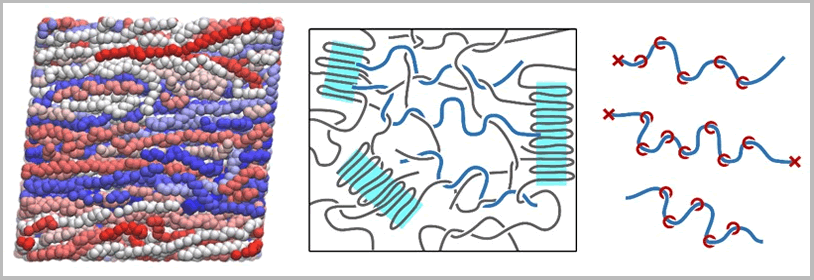Multiscale Modeling of Industrial Processing of Crystallizable Polymers
Modeling of polymer processing is a subject of continuing industrial and theoretical interest. However, competition in the market and the need to reduce ecological footprint force the industry to seek for next-generation tools for the design of polymer materials and products. We are building a multiscale model for polymer processing with three components: atomistic molecular dynamics, mesoscale model and computational fluid dynamics. Since industrial polymer melts undergo crystallization during processing, we are focused on atomistic and mesoscale/rheological modeling of crystallizing polymers, while experiments and polymer characterization and CFD calculations are performed by our collaborators at Dow Chemical, NIST, and MIT.
Atomistic level modeling.
Personnel: David Nicholson
Simulations of crystallization are carried out predominantly using the molecular dynamics (MD) method. The polyethylene molecules are modeled at the united atom level, where one “bead” corresponds to a CH2 or CH3 group. Crystallization is induced by quenching below the polymer melting temperature in the NPT ensemble. By monitoring the formation of clusters in the melt for a large number of trajectories we can connect the process to a stochastic description of crystallization using the mean-first passage time (MFPT) formalism. We observe crystallization behavior under quiescent and flow-induced crystallization. The goal of this research is to gain a theoretical understanding of how the crystallization process occurs, allowing us to use this information in coarse-grained models and experimental studies.
Mesoscale/rheological model.
Personnel: Marat Andreev
Rheology, or study of polymers flows, is important to understand for industrial processing. Industrial-grade materials are complicated due to broad polydispersity, chain-chain entanglements, short-chain branching, and semi-crystalline structures. We use a mesoscale computational slip-link model that is capable of capturing all these aspects. Slip-link models are attractive for their physically measurable parameters and have been demonstrated to be very capable of describing the rheology of entangled melts under a variety of non-linear deformation conditions, including shear, extension, and start-up. Our work is to expand the model to capture the effects of non-linear deformation and on-going crystallization during processing.
